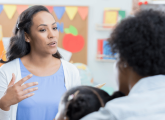Here’s how you can do more to help your setting’s children get active, says Emma Young…
It’s a sad truth that in recent years society has been guilty of overlooking the importance of physical activity in young people. Changes in lifestyle, including increased usage of tablet computers and games consoles, and a too narrow focus on academic achievement in schools mean that children are spending more time sitting down in a sedentary state than ever before. As a consequence, research suggests we now have young people dying five years earlier than the previous generation due to inactivity.
At present, less than 10% of children aged 2–4 years achieve the Chief Medical Officers’ recommendations for 180 minutes of physical activity every day. This is an obvious focus around which early years practitioners can educate themselves and parents in understanding the importance of physical activity and its long-standing benefits.
The aim for practitioners must be to develop children’s ‘physical literacy’ – “the motivation, confidence, physical competence, knowledge and understanding that provides children with the movement foundation for lifelong participation in physical activity”.
A healthy, active lifestyle is possible for every child. This is the stance we must take in order to combat the current trend and make our contribution to creating healthy, happy individuals who are capable of succeeding in life. The early years are critical for instilling a love of movement and the necessary building blocks for children to move well and move more. Physical activity plays a vital role in physical and emotional development and specifically for brain function. The evidence is clear: increased physical activity and reduced sitting time will have a direct impact on wellbeing and ultimately result in increased cognition and achievement.
To improve your setting’s approach to physical development, consider the following:
Training – There are now qualifications available to develop and upskill practitioners in how to deliver high-quality physical development opportunities for children in the early years. Holistic development of the whole child through physical activity is now being recognised as an important strand of learning. The value of supporting the foundations of movement and helping children achieve the ABCs of agility, balance and coordination cannot be underestimated.
EYFS framework – How can this be delivered in a more active way? Children love to move and play, so physical activity should be incorporated into their normal day, by creating an environment that allows freedom of movement. Why shouldn’t a story such as The Gruffalo be used to create active play opportunities rather than it being read to children sitting on the carpet? Take the carpet away – in fact, take all the chairs away as well!
Equipment & resources – Building blocks, soft play shapes, etc. are all great ways to help encourage physical activity. There are also resources available to practitioners to help them to deliver active play and meet the requirements of the EYFS Framework.
Parents – Getting parents on board is vital. Physical activity must be embedded within all areas of life, and it needs to be a team effort in order to meet the recommended guidelines and achieve ‘school readiness’ in very young children.
However we do it, it’s essential we remove the barriers to being active – and the early years phase of a child’s life is critical for getting this right. Early years practitioners have the opportunity to help build a socially mobile and healthy generation of children who grow up to be a healthy weight and emotionally well, with a long and happy life ahead of them.
The Youth Sport Trust is a national charity dedicated to building a brighter future for young people through physical activity. It has developed a new suite of resources and training specifically for early years practitioners and parents called Healthy Movers.

Early Years SENCo – How to succeed in the role
Editors picks

CV update – Why you should do it on holiday
Editors picks

Training interview: Safeguarding
Ace-Owner
